Abstract
Coal mining is still an important part of the global energy complex. Despite the active development of technologies and modern equipment, coal mining remains one of the most dangerous jobs in the world. The main danger is associated with a large number of the hard-predictable factors, such as the opening of a toxic and flammable gas blister, the collapse of a mine due to a violation of the mines’ structural integrity, etc. There are software and hardware systems capable of monitoring the necessary parameters, but the problem lies in the complexity and costliness of the implementation and maintenance, so even for the largest enterprises, the widespread implementation of such systems is unprofitable. Previously conducted studies have established that most of the developed coal mining monitoring systems are very expensive to implement and labor-consuming to use and support. This article proposes to consider the developed prototype of a system for toxic and flammable gases concentration real-time monitoring, capable of reading the information with sufficient speed and transferring it to a system which triggers the response mechanism in cases where the specified concentration limits would be exceeded.
1. Introduction
Coal is a significant source of heat energy worldwide. The fuel coal industry provides heating of housing and communal complexes, the movement of vehicles, as well as electricity generation. In industry, this resource is used to ensure furnaces’ operation, as well as for the manufacture of nitrogen fertilizers, plastic products, explosives, and alcohols [1].
During expert assessments of the coal’s industry condition, the share of this fossil is approximately 27% of all fuel total indicators. In the field of metallurgy, as well as the field of electric power industry, coal is always used as a fuel more actively than other industries. About 44% of all electricity in the world is produced using coal products. Given the current trend of replacing gas with coal, in the fuel industry of countries such as China, the USA, India, South Africa, and Australia, it can be concluded that the coal industry is one of the main vectors for the development of energy in advanced countries [2,3].
However, along with active development, this industry is also one of the most dangerous in terms of the workers’ deaths risk. Coalmines located in the territory of the Russian Federation remain one of the most dangerous facilities compared to enterprises in other countries. It should be taken into account that in Russia, a significant percentage of underground mining is carried out in unfavorable mining and geological conditions. In the Russian Federation, 19 coalmines (31.7%) operate at a depth of about 500 m; two mines, Vorkutinskaya and Komsomolskaya, operate at a depth of up to 1 km. In 2018, the average depth of mines in Russia reached 482.5 m against 431 m in 2010. Among coal seams, 90.8% are classified as hazardous according to one of the influencing factors, and 74% of the given mines are dangerous according to two or more factors at the same time. The percentage of those layers that are dangerous due to the explosiveness of the dust is critically high—87.3% [4].
2. Problem Statement
During the process of coalmines developing by the underground method, it is necessary to be sensitive to possible emergencies, which really affect the level of danger and lead to accidents and injuries at coal-mining enterprises.
Significant hazards at coalmines can appear during the intensive mining in difficult conditions: methane explosions, ignition of coal dust, rock collapse, water breakthroughs, release of explosive gases, sudden outbursts of coal and gas, underground fires. Analyzing the statistics of accidents in the coalmines of the Kemerovo region, companies in the coal industry are ready to actively finance the provision of industrial safety and human labor protection. Since 2004, there have been approximately 20 accidents in coalmines and 220 victims, 206 of whom died due to gas explosions—methane. This problem significantly reduces the competitiveness of coal enterprises [5].
Another acute problem is the increase of the cost of coal due to the unprofitability of investments in the automation of technological and supporting processes, which is directly related to the high cost of imported equipment. The coal industry is lagging behind in the global implementation of mining automation, 3D technologies in modeling and designing deposits, studying the development of geological exploration and mining, and monitoring the state of physical processes. The increase in labor productivity at the coal enterprises of the Russian Federation often occurs due to the involvement of more human resources. The use of a generally approved industrial safety management system will significantly reduce the risk of occupational diseases and industrial injuries. The implementation of this type of system for the remote monitoring of the state of physical processes in coal deposits provides for automated collection, consolidation, generalization, systematization, and analysis of information about the obtained values of the parameters of the state of physical processes in order to determine the state of industrial safety.
As a solution to the above problems, the development and implementation of specialized systems for monitoring physical processes in coal deposits to analyze the hazard factor at coal enterprises and justify a set of actions aimed at the timely notification of danger, which will increase the safety and productivity of underground mine operations, are proposed. The purpose of this study is to develop a system with the optimal combination of functionality and implementation costs.
The relevance of this development is that at this moment, it is important for Russian coalmines to reduce the number of accidents and eliminate work-related injuries. Such problems in coalmines arise due to an inefficient control and monitoring system in coalmines, as well as due to the lack of forecasting of hazardous phenomena and the lack of work to prevent dangerous physical and mechanical phenomena in advance.
Monitoring systems for physical processes in coalmines significantly increase labor productivity through monitoring, effective management, data collection, and the timely notification of workers in coalmines. Monitoring is an important step in the automation of a mining enterprise, as it allows you to transfer part of the authority in managing production and making managerial decisions from a person to artificial intelligence.
3. Methods
Often, enterprises in Russia mine coal at a depth of more than one kilometer. With an increase in the depth of work, the risk of developing adverse processes increases significantly, e.g., an increase in the concentration of toxic or combustible gases (the release of methane emissions from coal-bearing seams, etc.), partial/complete collapse of the mine roof [6,7]. The presented phenomena are extremely dangerous for workers in a coalmine; therefore, the main goal of developing a monitoring system is to ensure the safety of personnel during mine operations at coal-bearing enterprises.
The probability of an accident in a coalmine is determined by the conditions that occurred naturally and the development of coal seams, and significantly depends on the elimination of various sudden and predictable manifestations of natural and industrial hazards with the approved technology for conducting mine operations and the efficiency of the entire monitoring structure against accidents for the protection and training of workers at coal enterprises personnel of all professions.
To detect stresses and deformations, the primary signal and the received signal in the coal seam are correlated [8]. The application and use of pulsed signals is the basis and substantiates the use and operation of the ultrasonic logging method [9,10].
X-ray and radiation underlie the methods of gamma radiation and are their basis. Three concepts underlie all of the gamma methods that mine workers use to assess rock porosity: the wide beam method, the narrow beam method, and the scatter gamma ray method. Depth requirements are not subject to the above scientific methods due to the very small ability to seep through. This makes it possible to evaluate rocks by porosity [11,12,13]. Ionizing radiation is rarely used to analyze and monitor coal seam stresses, as it requires the use of specialized protective equipment and is characterized by hazardous production factors. In the conditions of coal mining in the mine method, the wide beam method is most often used, whereas the method differs from the remaining measurements, which is carried out both scattered and with radiation with initial data and concentrations. Since all rocks are and will continue to be dielectrics [14], in order to determine the level of stresses in a coal mass, auxiliary laboratory diagnostics are required [15]. The interaction of pressure and electrical resistance of rocks is the essence of the electrometric method and this is discussed in the sources [16]. Such methods do not specialize in determining their absolute values, but only allow obtaining very high-quality information about the redistribution and redirection of stresses in a rock mass.
In the process of formation imbalance (for example, due to breaking coal or drilling a well), the process of active mass transfer of methane develops, as well as its desorption and entry into the area of reduced pressure, i.e., to the mining area [17,18]. The exclusivity of the phenomenon of methane ingress from a coal-bearing seam can be noted the superposition of two processes of mass transfer:
- Gas ventilation using a system of open cracks;
- The transition of methane from the solid solution into the filtration volume.
Filtering is the main process in this context. As the filtration progresses, the gas pressure in the filtration volume decreases, which entails the formation of a thermodynamic force for the desorption of methane from the blocks into the filtration volume through diffusion.
The occurrence of coal seams occurs under the following physical processes and conditions: the distance that is formed between these layers, the number of these layers that are located in the same area, the thickness of each layer of rocks, the angle of incidence, disturbance and destruction of the layers, destruction and disturbance, water that is formed in coal seams, temperature indicators of seams, and the temperature of layers that are located near seams with coal [19].
The chemical, physical, and mechanical properties and features of coal deposits and rocks that contain coal minerals are jointing, collapse, predisposition of rocks and plats to impacts, strength, dust explosion hazard, tendency of coal to oxidize, degree of metamorphism, and the proportion of free and released silicon [20].
Hazardous phenomena leading to accidents due to natural modifications or any other processes caused by nature are:
- The release of methane, which is most dangerous due to its flammability;
- Collapse and destruction;
- The danger of coal because it belongs to flammable fossils;
- Sudden release of various types of gases;
- Disturbances in the formation itself;
- Emission of coal dust;
- Appearance or formation of water in formations;
- Geological destruction and reservoir disturbance;
- Increase in the temperature of rocks with the deepening of the mine.
Table 1 and Table 2 describe the quantitative data on the main objects that affect the occurrence of accidents [13]. As described above, the type of occurrence of accidents and fires differs, but in this case, accidents can occur not only due to one influencing factor, but also due to several factors and influencing objects. All of this naturally affects the difficulty of monitoring, analyzing, and predicting physical hazardous processes, so it is of paramount importance to analyze the existing experience and, first of all, pay attention to the most common hazard phenomena and work on their prediction and elimination [21].

Table 1.
Classification by objects leading to accidents at Russian coal enterprises.

Table 2.
Classification by types of accidents at coal enterprises in Russia.
When analyzing the given tables data described, it can be assumed that the most dangerous is the special equipment using—80 percent of all kinds of accidents, due to which, accidents occur, which most often lead to fires, which are difficult to extinguish. Nearly 17 percent of accidents are due to the destruction and initial disturbance of coal rocks, and this includes underground fires, methane explosions, coal dust explosions and ignitions, and explosions from other flammable substances [22,23]. This leads to the conclusion that the means and capabilities of the monitoring, observation, and analysis of physical processes are used insufficiently. In order to provide early warning of possible negative consequences of physical processes, it is advisable to constantly monitor the state of coal seams in the processing zones and tunnels of the enterprise, as well as to assume and predict the possibility of such phenomena.
All sorts of information and analytical systems studied at coal mining enterprises do not contain the functionality for obtaining real-time information from mine workers about dynamic phenomena that have occurred in their vicinity. In this case, constant monitoring and forecasting of such phenomena could create conditions for work in mine areas that are dangerous due to dynamic phenomena. In order to diagnose fast dynamic phenomena in a mountain range, it is necessary to create a continuous monitoring of the mine, namely its underground sections; the conduct of mine operations must be at a certain level of safety both for the team and for the outside world [24]. An early assessment of the state of shock hazards and outburst hazards occurs on the basis of obtaining continuous data on the massif and its state; it is also necessary to monitor and forecast depending on the early assessment and geological conditions [25,26]. Without constant monitoring of the mountain range, it is unrealistic to ensure the safety of mining operations.
4. Results
When developing physical process monitoring for the coal deposits, it is necessary to analyze those processes that occur in a coal-bearing seam, describing the physic essentials of the following processes. The danger of the coal mining process contains two main factors: the self-pressure of the layers and the possible changes of the methane pocket conditions and pressure [27]. The influence of those factors become stronger with the mining process intensity and depth increasing. The main problem is that those processes proceed in a short time, which makes it impossible to react and makes it necessary to arrange the real-time monitoring [28].
The proposed monitoring algorithm has three stages:
- “Data acquisition” is necessary to receive and collect the coal mining processes’ parameters.
- “Graphing” is necessary to visualize the received data on the operator’s station, which gives an opportunity not only to see the actual responses from the sensors, but also analyzes the parameter distribution regularities to predict the possible emergencies.
- “Maintaining a document with read data” is necessary to collect and write all the data to the files, which gives an opportunity to conduct operation analysis and better-detailed future investigations.
The monitoring system makes it possible in real time to display the received information on all sensors used in monitoring. Table 3 shows the MPC (Maximum Permissible Concentration) for each indicator, as well as the sensors that are used to measure indicators. For the model of monitoring the state of physical processes in coal deposits, the following sensors, methane, propane, carbon monoxide, carbon dioxide, and sour gas sensors, are used.

Table 3.
Basic parameters of sensors.
The control of the content of methane, propane, carbon monoxide, carbon dioxide, and N-gas is carried out in the bottom-hole sections of workings in a dead end with a length of 10 m or more and outgoing sections with a mine length of 50 m or more, provided that the mines use electrical energy and methane emissions are formed. When operating in dead ends of a mine, a moving substation is used in the area of the substation. In the case, when mining was carried out during drilling and blasting, operations and concussion explosions can be produced. Those emergencies are not dependent on the use of electrical energy, in the dead ends of the mine, which are unsafe due to methane emissions. A coalmines’ where the digging depth over of 100 m, the subject to the use of electrical energy in addition to areas of various accumulations was used.
Control of the methane, propane, carbon monoxide, carbon dioxide, and N-gas concentration was carried out in the bottom-hole sections of workings in a dead end with a length of 10 m or more and outgoing sections with a mine length of 50 m or more, provided that the mines use electrical energy and methane emissions are formed. When operating in dead ends of a mine, a moving substation was used—in the area of the substation. If mining was carried out during drilling and blasting operations and concussion explosions can be produced, which is not dependent on the use of electrical energy, in the dead ends of the mine, which are unsafe due to methane emissions, a duration of 100 m, subject to the use of electrical energy, in addition to areas of various accumulations was used:
- In areas of ventilation of external ventilation with electric motors during underground mining of reservoir deposits, which are unsafe due to the likelihood of sudden outbursts, as well as under the condition of operation of fans in areas with an outgoing air stream from workings stopping and workings in blind alleys;
- In the air entering the workings with downward ventilation, with sequential ventilation and under the condition of coal mining from seams;
- Near the outgoing air from the workings, subject to the use of electrical energy, and in the areas of excavation, without reference to the use of electrical energy;
- In dead ends of ventilation working;
- In areas where the machinery and electrical equipment are operated, which are ventilated with outgoing air, and in areas where electrical equipment is installed;
- In areas with outgoing air outside the excavation areas (up to shafts), provided that these areas contain machinery and electrical equipment or cables;
- In the outgoing jets of mine structures;
- At mixers of gas suction units;
- In the chambers of fans for gas suction.
When receiving information about exceeding the agreed threshold, the monitoring system warns of the danger with a sound or light signal. The time interval between the sound signal for stationary sensors installed in the mine and the receipt of information from them should not be more than 10 s.
The system for monitoring physical processes in coal deposits is an air-gas control system that is necessary to ensure the safety of underground mine operations through continuous monitoring of the parameters read from sensors, which characterize the gas regime of the mine [24]. Monitoring can be described in more detail as follows: we collect the indicators of gas sensors and save them to a PC; for the convenience of information perception, we display the saved information from the sensors on graphs, and we also save information about the parameters of the gas mode for a certain period of time for further information analytics, which is extremely important for the control of installations and equipment, which maintains safety in terms of air and gas conditions in coalmines [23]. The sensor connection diagram is shown in Figure 1.
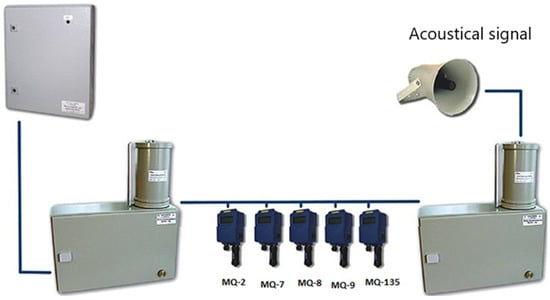
Figure 1.
The scheme of the sensors connecting.
This monitoring system is required to perform the following functions:
- Air and gas monitoring in areas where sensors are installed in places in coalmines (sensors are described and presented in Table 1);
- Automatic control of the occurrence of hazards due to increased concentration and the ability to remotely activate the operation of ventilation units in a coalmine;
- Activation of ventilation to ventilate the areas of the face of the mine during preparation for extraction in offline mode, as well as their control;
- Automatic danger alert;
- Automated control of equipment to maintain a safe aero-gas state in coalmines.
All described functions are used as a system that provides the following procedures and operations:
- Provision of notification with a sound signal and turning on and off of light indicators, which is a signal for workers in a coalmine about an emergency (this procedure is carried out by the operator and dispatcher);
- Data from sensors and sensors on the concentration of gases in the coalmine are checked and monitored continuously by the dispatcher and the operator, and the operator monitors the preservation of information on the concentration of gas;
- There is a procedure for shutting down machinery and other equipment that uses electrical energy. This de-energization procedure occurs automatically when a dangerous concentration of gases is detected or the shutdown is performed by the dispatcher;
- Procedure for rapid replacement or reconfiguration of the system for monitoring physical processes in coal deposits in the event of a hazardous event;
- Saving data that were written off from sensors and transmitters for the analysis of events after some time.
The APCS diagram is shown in Figure 2.
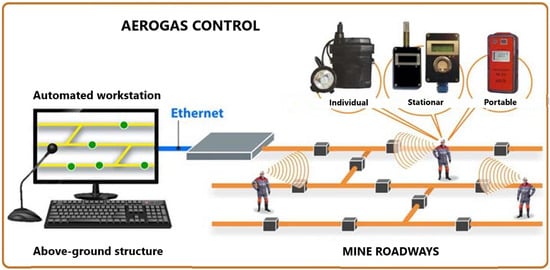
Figure 2.
PACS for gas-dynamic phenomena in mine monitoring.
Based on the research results, a layout was developed to represent a visual model of the system for monitoring physical processes in coal deposits (Figure 3).
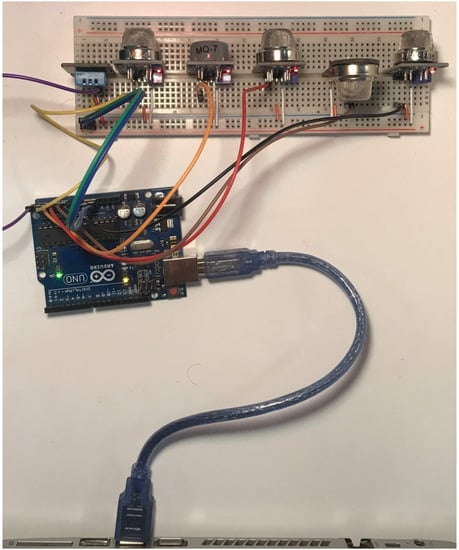
Figure 3.
The layout of the coal deposit system physical processes monitoring.
The structure of the presented system includes:
- USB cable for power supply and transfer of read data;
- Arduino microcontroller for reading and processing gas concentration data from sensors. Signal—two wires (green and blue) and power wires—the remaining six wires;
- Prototyping board that provides connection of sensors to the controller, and also allows them to be placed in different configurations;
- Sensor MQ-135—measurement of CO_2 (more precisely, the concentration of carbon dioxide in the atmosphere);
- Sensor MQ-2—measurement of concentration in the atmosphere of propane;
- MQ-9—measurement of CH_4 (more precisely, the concentration of methane in the atmosphere);
- MQ-7 sensor—measurement of carbon monoxide concentration in the atmosphere;
- Sensor MQ-4 measurement of sulfur dioxide in the atmosphere of mine structures;
- Next, it is proposed to consider the development of the system software.
The software was developed using the C language. The operation algorithm of the prototype gas concentration monitoring system in a coalmine consists of the following steps:
- Connecting libraries to simplify work with sensors and other components;
- The maximum number of possible parameter measurements is determined;
- Variables containing the parameters of each gas are presented as an array;
- The minimum and maximum values for the y-axis are determined;
- The primary array of data received from the sensors is formed;
- Calling the module for constructing a graph and creating a session data storage file;
- Calling the function that sets the basic parameters of clean air for each concentration;
- Calling a function that checks the compliance of each output of the Arduino board with a given device;
- Calling the function of the initial configuration of the library of each used sensor;
- Calling the function of measuring carbon dioxide parameters from the MQ-135 sensor;
- Calling the function of measuring gas parameters—propane from the MQ-2 sensor;
- Calling the function of measuring natural gas parameters from the MQ-4 sensor;
- Calling the function of measuring gas parameters—methane from the MQ-4 sensor;
- Calling the function of measuring carbon monoxide parameters from the MQ-7 sensor;
- The received data are recorded, transmitted to the workstation, and recorded.
Figure 4 shows the system interface, which displays graphs of the changes in gas concentration. The graphical presentation of information is convenient in operation, as well as for the analysis of changes occurring in coal deposits.
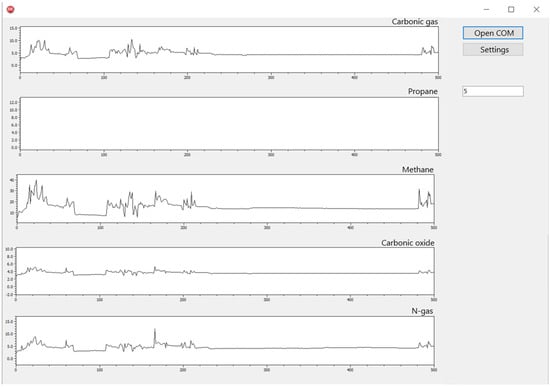
Figure 4.
Monitoring system prototype interface.
An important document that was developed and executed is a document presented in a convenient table format, where each column is allocated for the parameters of each individual gas, and where information on the concentration of gases is prescribed and stored. An example of such a document is shown in Figure 5.
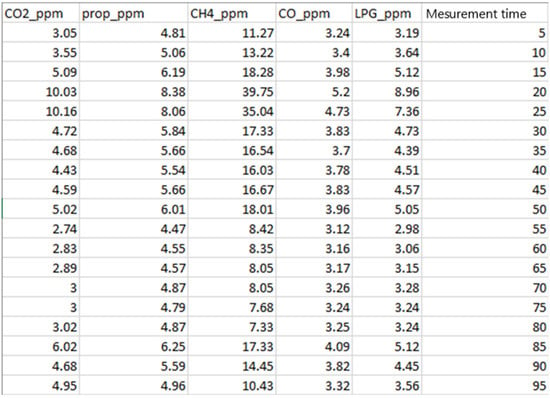
Figure 5.
An example of a writing data file.
For convenient use and prompt notification of a dangerous concentration of gas emissions, a graph showing the concentration of gas when the concentration is exceeded notifies of the danger by highlighting the graph in red. To alert workers who are directly in the coalmine, an audible signal is turned on, which notifies of the danger. The result on the example of exceeding the norm of the concentration of methane emissions is shown in Figure 6.
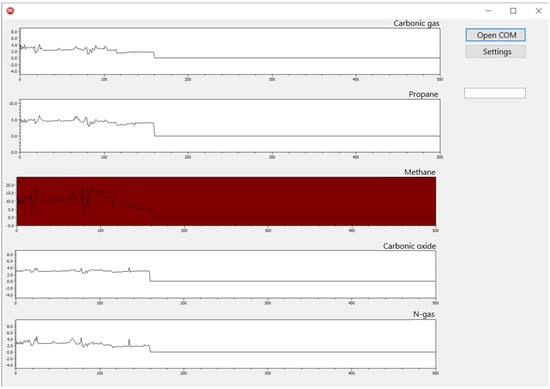
Figure 6.
Display of the system’s response to exceeding the permissible parameters of the gas content.
The program code described above for reading information about the concentration of gases in a coalmine; the program code for plotting graphs that clearly show the concentration of dangerous gases; and the program code for collecting, storing, and analyzing the received data on gas concentration will ensure the monitoring of physical processes in coal deposits. Such a structure of actions makes it possible to notify workers in time about a dangerous concentration of gases, to predict dangerous physical processes in coal deposits, and to analyze at what concentration and saturation values of certain gases physical processes occurred, which affect the structure of coal mining.
Given the average number of mining areas and mines, the implementation of a full-fledged system will require an enormous investment of funds and capacities. An alternative to this solution could be a system that has a smaller set of functions, but is able to monitor the most important safety indicators (gas concentration in a coalmine). The proposed solution is a software and hardware complex capable of perceiving the information from sensors and transmitting it to the operator’s workstation. The main functions of the system are the constant monitoring of the concentration of the most frequently occurring gases, alerting the operator and personnel in case of reaching critical concentration indicators and generating an observation log, on the basis of which an analysis of the dynamics of changes in gas concentration can be subsequently carried out depending on the nature, duration, and intensity of work. The accumulated amount of knowledge can be used as input data for a future forecasting system, as well as possible scientific research in this subject area.
5. Conclusions
The article presents the process of developing a prototype system for monitoring the concentration of toxic and flammable gases in a coalmine. The analysis of the subject area revealed that there are several full-featured developments that can not only monitor the target parameters of gas concentration, but also model the nature and speed of its distribution. The advantages of these type of systems are an ergonomic interface and a wide range of analysis, monitoring, and triggering functions, but the problem is the high complexity of implementing such systems. In addition to the high cost, the use of these systems implies making changes to each stage of the production process, including the installation of new equipment, changing the structure of the data transmission network, partial replacement of operator workstations, and a set of sensors and sensors. The complexity and importance of setting up the system makes it necessary to hire a narrowly specialized specialist who must not only perform the initial setup and calibration of the equipment, but also train the staff. In response to this, a large-scale spreading implementation of simple, but functionally sufficient, systems was found.
As the result of this study, a prototype including a programmable board and a set of sensors capable of measuring the concentrations of the most common gases was developed. The test results showed that the proposed set of sensors and the computational circuit are capable of determining the concentration of dangerous gases with sufficient accuracy, transmitting data to the system and ensuring the timely response of the system when critical indicators are reached.
The presented studies are the first stage of our own full-featured system for controlling and monitoring the gas contamination of coalmine development.
Author Contributions
Conceptualization, Y.V.I. and A.V.M.; methodology, A.V.M.; software, Y.V.I.; validation, A.V.M.; formal analysis, Y.V.I.; investigation, A.V.M.; resources, Y.V.I.; data curation, A.V.M.; writing—original draft preparation, A.V.M.; writing—review and editing, Y.V.I., A.V.M.; visualization, A.V.M.; supervision, Y.V.I.; project administration, A.V.M.; funding acquisition, Y.V.I. All authors have read and agreed to the published version of the manuscript.
Funding
This research received no external funding.
Conflicts of Interest
The authors declare no conflict of interest.
References
- Morozov, K.V. Key approaches to the advance degassing of coal beds of the promising Kuzbass deposits. J. Min. Inst. 2013, 205, 125. Available online: https://pmi.spmi.ru/index.php/pmi/article/view/5505 (accessed on 15 November 2022).
- Slastunov, S.V.; Mazanik, E.V.; Sadov, A.P.; Khautiev, A.M.-B. Testing of integrated degasifying treatment technology based on hydraulic splitting of coal seam using surface holes. Min. Inf. Anal. Bull. 2020, 2, 58–70. [Google Scholar] [CrossRef]
- Zhu, Z.; Zhang, H.; Nemcik, J.; Lan, T.; Han, J.; Chen, Y. Overburden movement characteristics of top-coal caving mining in multi-seam areas. Q. J. Eng. Geol. Hydrogeol. 2018, 51, 276–286. [Google Scholar] [CrossRef]
- Slastunov, S.; Kolikov, K.; Batugin, A.; Sadov, A.; Khautiev, A. Improvement of Intensive In-Seam Gas Drainage Technology at Kirova Mine in Kuznetsk Coal Basin. Energies 2022, 15, 1047. [Google Scholar] [CrossRef]
- Hirschi, J.C. The role of research in the coal-mining industry: Moving forward using lessons from the past. In Advances in Productive, Safe, and Responsible Coal Mining; Elsevier: Amsterdam, The Netherlands, 2018; pp. 303–312. [Google Scholar]
- Gendler, S.G.; Gabov, V.V.; Babyr, N.V.; Prokhorova, E.A. Justification of engineering solutions on reduction of occupational traumatism in coal longwalls. Min. Inf. Anal. Bull. 2022, 1, 5–19. [Google Scholar] [CrossRef]
- Korshunov, G.I.; Eremeeva, A.M.; Drebenstedt, P. Justification of the use of a vegetal additive to diesel fuel as a method of protecting underground personnel of coalmines from the impact of harmful emissions of diesel-hydraulic locomotives. J. Min. Inst. 2021, 247, 39–47. [Google Scholar] [CrossRef]
- Mayet, A.M.; Alizadeh, S.M.; Nurgalieva, K.S.; Hanus, R.; Nazemi, E.; Narozhnyy, I.M. Extraction of time-domain characteristics and selection of effective features using correlation analysis to increase the accuracy of petroleum fluid monitoring systems. Energies 2022, 156, 1986. [Google Scholar] [CrossRef]
- Reker, B.; Westermann, S.; Goerke-Mallet, P.; Melchers, C. Mine Water Rebound Processes in Europe. In Proceedings of the 2020 SME Annual Conference and Expo, Phoenix, AZ, USA, 23–26 February 2020. [Google Scholar]
- Stroykov, G.A.; Babyr, N.V.; Ilin, I.V.; Marchenko, R.S. System of comprehensive assessment of project risks in energy industry. Int. J. Eng. 2021, 34, 1778–1784. [Google Scholar] [CrossRef]
- Litvinenko, V.S.; Dvoinikov, M.V. Methodology for determining the parameters of drilling mode for directional straight sections of well using screw downhole motors. J. Min. Inst. 2020, 241, 105. [Google Scholar] [CrossRef]
- Łabęda-Grudziak, Z.M. The Disturbance Detection in the Outlet Temperature of a Coal Dust–Air Mixture on the Basis of the Statistical Model. Energies 2022, 15, 7302. [Google Scholar] [CrossRef]
- Sathishkumar, N.; Manoj, A.; Muniraj, K.; Naveenkumar, M.; Praveen, C. Safety Monitoring System in Coal Mine Using IoT. J. Phys. Conf. Ser. 2021, 1916, 012196. [Google Scholar] [CrossRef]
- Petrakov, D.G.; Penkov, G.M.; Zolotukhin, A.B. Experimental study on the effect of rock pressure on sandstone permeability. J. Min. Inst. 2022, 254, 244–251. [Google Scholar] [CrossRef]
- Puchcov, L.A.; Slastunov, S.V.; Karkashadze, G.G.; Kolilov, K.S. Justification of Optimum Permitted Exploration of Working Coal Face Related to Coal Seam Gas Content. In Proceedings of the International Coalbed Methane Symposium, Birmingham, AL, USA, 17–21 May 1993. [Google Scholar]
- Kobylkin, S.S.; Kharisov, A.R. Design features of coalmines ventilation using a room-and-pillar development system. J. Min. Inst. 2020, 245, 531–538. [Google Scholar] [CrossRef]
- Xue, X.; Wang, C.; Ma, H.; Mao, Q.; Cao, X.; Zhang, X.; Zhang, G. Self-Derived Wavelet Compression and Self Matching Reconstruction Algorithm for Environmental Data in Complex Space of Coal Mine Roadway. Energies 2022, 15, 7505. [Google Scholar] [CrossRef]
- Khayrutdinov, M.M.; Kongar-Syuryun, C.B.; Khayrutdinov, A.M.; Tyulyaeva, Y.S. Improving safety when extracting water-soluble ores by optimizing the parameters of the backfill mass. Bezop. Tr. V Promyshlennosti 2021, 2021, 53–59. [Google Scholar] [CrossRef]
- Korshunov, G.I.; Eremeeva, A.M.; Seregin, A.S. Justification of reduction in air requirement in ventilation of coal roadways with running diesel engines. Min. Inf. Anal. Bull. 2022, 2022, 47–59. [Google Scholar] [CrossRef]
- Liang, G. Control and communication co-design: Analysis and practice on performance improvement in distributed measurement and control system based on fieldbus and Ethernet. ISA Trans. 2014, 54, 169–192. [Google Scholar] [CrossRef]
- Cheng, B.; Cheng, X.; Chen, J. Lightweight monitoring and control system for coal mine safety using REST style. ISA Trans. 2014, 54, 229–239. [Google Scholar] [CrossRef]
- Zhu, Y.; You, G. Monitoring System for Coal Mine Safety Based on Wireless Sensor Network. In Proceedings of the 2019 Cross Strait Quad-Regional Radio Science and Wireless Technology Conference (CSQRWC), Taiyuan, China, 18–21 July 2019; pp. 1–2. [Google Scholar] [CrossRef]
- Golovina, E.; Karennik, K. Modern Trends in the Field of Solving Transboundary Problems in Groundwater Extraction. Resources 2021, 10, 107. [Google Scholar] [CrossRef]
- Novozhilov, I.M.; Ilyushina, A.N.; Asadulaghi, M.-A.M.; Antropova, V.V.; Kuharova, T.V. Development of a Spatially Distributed Mathematical Model of a Formation of Complex Shape. Izv. LETI 2021, 10, 63–69. [Google Scholar]
- Arefiev, I.B.; Afanaseva, O.V. Implementation of Control and Forecasting Problems of Human-Machine Complexes on the Basis of Logic-Reflexive Modeling Lecture Notes in Networks and Systems. Int. Conf. Syst. Anal. Eng. Control 2022, 422, 187–197. [Google Scholar]
- Rybak, J.; Khayrutdinov, M.M.; Kuziev, D.A.; Kongar-Syuryun, C.B. Prediction of the geomechanical state of the rock mass when mining salt deposits with stowing. J. Min. Inst. 2022, 253, 61–70. [Google Scholar] [CrossRef]
- Singh, A.; Singh, U.K.; Kumar, D. IoT in mining for sensing, monitoring and prediction of underground mines roof support. In Proceedings of the 2018 4th International Conference on Recent Advances in Information Technology (RAIT), Dhanbad, India, 15–17 March 2018; pp. 1–5. [Google Scholar]
- Li-min, Y.; Anqi, L.; Zheng, S.; Hui, L. Design of monitoring system for coal mine safety based on wireless sensor network. In Proceedings of the 2008 IEEE/ASME International Conference on Mechtronic and Embedded Systems and Applications, Beijing, China, 12–15 October 2008; pp. 409–414. [Google Scholar]
Publisher’s Note: MDPI stays neutral with regard to jurisdictional claims in published maps and institutional affiliations. |
© 2022 by the authors. Licensee MDPI, Basel, Switzerland. This article is an open access article distributed under the terms and conditions of the Creative Commons Attribution (CC BY) license (https://creativecommons.org/licenses/by/4.0/).